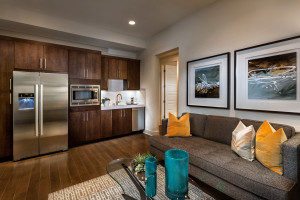“Multigenerational” living is common in many other cultures.
But in the U.S., to have three or more generations living under one roof (as defined by the U.S. Census) is a new–but fast-growing–trend due to immigration, longer lifespans and, to a small extent, “boomerang” kids.
According to American Community Survey data, in 2012 there were 4.4 million multigenerational households in the U.S., accounting for more than 5.7% of all family households. This represents a noticeable increase from 1990, when only 2.9 million homes were multigenerational. That equates to a 26.7% rise in share.
Such growth means floor plans and design theories must change to keep up with this client base. For example, including elevators, common areas where several generations can gather comfortably, separate apartments, and more bedroom space–5.1 people live in multigenerational homes as opposed to 2.4 in standard living arrangements.
Read on for more background on this developing trend, as well as photos, descriptions and floor plans from what one Best in American Living Awards-winning community, Skylar at Playa Vista (Calif.), is doing to make room for multigenerational.
Related Articles:


